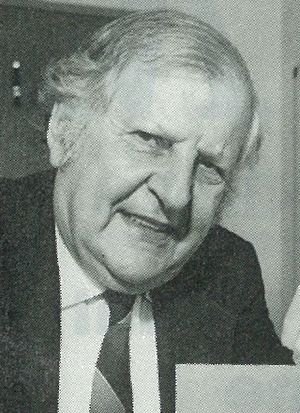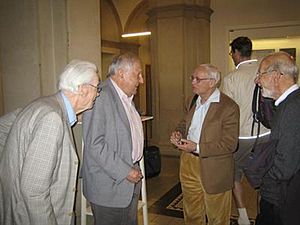Peter Hilton facts for kids
Quick facts for kids
Peter Hilton
|
|
|---|---|

Hilton in 1993
|
|
| Born |
Peter John Hilton
7 April 1923 London, England
|
| Died | 6 November 2010 (aged 87) Binghamton, New York, United States
|
| Alma mater | The Queen's College, Oxford |
| Known for | Eckmann–Hilton argument Eckmann–Hilton duality Hilton's theorem |
| Spouse(s) |
Margaret Mostyn
(m. 1949–2010) |
| Children | 2 |
| Scientific career | |
| Fields | Mathematician |
| Institutions | University of Birmingham Cornell University Case Western Reserve University Binghamton University University of Central Florida |
| Thesis | Calculation of the homotopy groups of  -polyhedra (1949) -polyhedra (1949) |
| Doctoral advisor | J. H. C. Whitehead |
| Doctoral students | Paul Kainen |
Peter John Hilton (born April 7, 1923 – died November 6, 2010) was a brilliant British mathematician. He is famous for his work in a field called homotopy theory. He was also a secret code-breaker during World War II, helping to crack enemy messages.
Contents
Early Life and Education
Peter Hilton was born in Brondesbury, London, England. His father, Mortimer Jacob Hilton, was a doctor. Peter grew up in Kilburn. His older brother, Sidney Montague Hilton, also became a well-known scientist.
Peter went to St Paul's School, London. In 1940, he earned a scholarship to study mathematics. He attended The Queen's College, Oxford, a famous university.
Code-Breaking at Bletchley Park
During World War II, Peter Hilton was a student at Oxford. He was supposed to join the army in 1942. Instead, he got a secret job with the Foreign Office. He was actually recruited to work at Bletchley Park. This was a top-secret station where British code-breakers worked. Peter was only 18 years old when he arrived there in January 1942.
Hilton worked with different groups at Bletchley Park. He first helped to break codes from the German Naval Enigma machine. This was in a section called Hut 8. He worked closely with Alan Turing, a very famous mathematician. Hilton said that working with Turing was like being with a true genius. He felt amazed by Turing's deep and original ideas.
Later in 1942, Hilton moved to work on German teleprinter codes. These were even more complex. He joined a special section called the "Testery". This group worked on a code named "Tunny". Hilton helped find new ways to deal with changes in the Tunny code. He also worked with another section, the "Newmanry". This group used special machines to help break the codes.
Fun Times at Bletchley Park
Even with all the serious work, Peter Hilton found time for fun. He enjoyed going to the pub with friends from Bletchley Park. He also spent time with Alan Turing solving chess problems. They even worked on creating palindromes. A palindrome is a word or phrase that reads the same forwards and backwards.
Hilton created a very long palindrome with 51 letters. He made it up in his head over one night, without writing anything down. It took him five hours! The palindrome was: "Doc note, I dissent. A fast never prevents a fatness. I diet on cod."
Contributions to Mathematics
Peter Hilton earned his PhD in 1949 from Oxford University. His main supervisor was John Henry Whitehead. Hilton's research focused on algebraic topology. This is a field of mathematics that uses tools from algebra to study shapes and spaces.
He also worked on other areas like homological algebra. Hilton wrote 15 books and over 600 articles. Many of these were with other mathematicians. One of his important ideas is called Hilton's theorem (from 1955). It helps understand how certain mathematical shapes fit together.
In 1948, Alan Turing invited Hilton to see the first computer, the Manchester Mark 1 machine. Around 1950, Hilton started working at the University of Manchester. He later moved to Cambridge, England, in 1952. There, he led a group that studied topology. Many famous mathematicians attended his seminars.
In 1955, Hilton began working with Beno Eckmann. Together, they developed an idea called Eckmann-Hilton duality. This is an important concept in mathematics.
Hilton became a professor at the University of Manchester in 1956. In 1958, he became a professor at the University of Birmingham. He moved to the United States in 1962. There, he taught at Cornell University and later at Case Western Reserve University. In 1982, he became a distinguished professor at Binghamton University. Even after retiring in 2003, he continued to teach at the University of Central Florida.
Family and Later Life
Peter Hilton passed away on November 6, 2010, in Binghamton, New York. He was 87 years old. He was married to Margaret Mostyn in 1949. They had two adopted sons. Margaret was a schoolteacher. She also had a career as an actress in the US. She passed away in 2020.
Academic Roles
Peter Hilton held many important teaching positions during his career:
- Lecturer at University of Cambridge, 1952–55
- Senior Lecturer at University of Manchester, England, 1956–58
- Mason Professor of Pure Mathematics, University of Birmingham, England, 1958–62
- Visiting Professor at the Eidgenössische Technische Hochschule at Zürich, ETH Zurich, several times
- Visiting Professor at the Courant Institute of Mathematical Sciences, New York University, 1967–68
- Visiting Professor at the Universitat Autònoma de Barcelona, Autonomous University of Barcelona, 1989
- Professeur invité, University of Lausanne, in 1996
Awards and Recognition
Peter Hilton received many honors for his work:
- Silver Medal from the University of Helsinki, 1975
- Doctor of Humanities (honorary degree) from N. University of Michigan, 1977
- Corresponding Member of the Brazilian Academy of Sciences, 1979
- Doctor of Science (honorary degree) from Memorial University of Newfoundland, 1983
- Doctor of Science (honorary degree) from the Autonomous University of Barcelona, 1989
In 1983, a special conference was held to celebrate Hilton's 60th birthday. Mathematicians presented papers dedicated to him. Another international conference was held in 1993 for his 70th birthday. In 1994, he was the Mahler Lecturer for the Australian Mathematical Society. He also visited the University of Canterbury in New Zealand as a Visiting Erskine Fellow.
Images for kids




